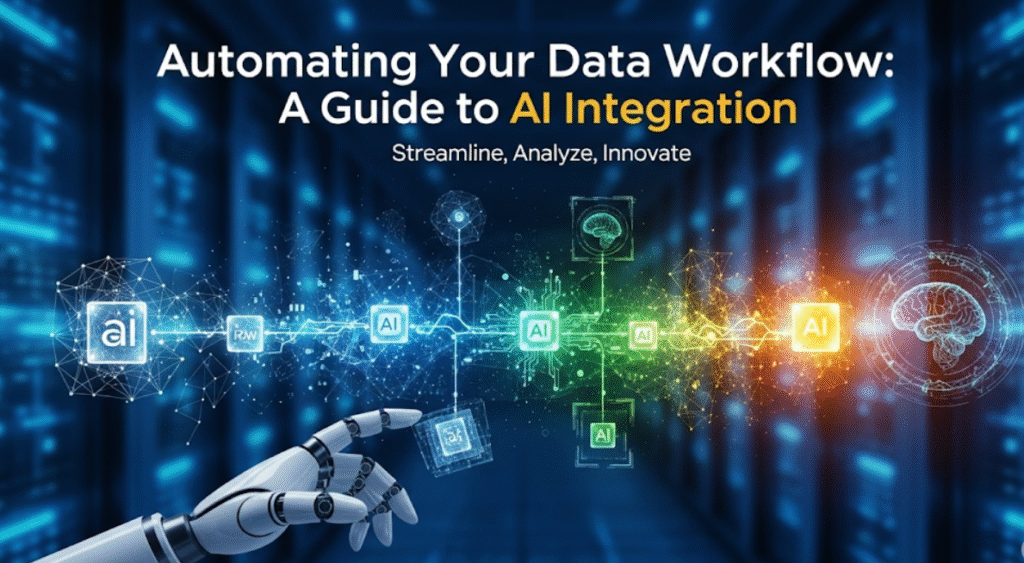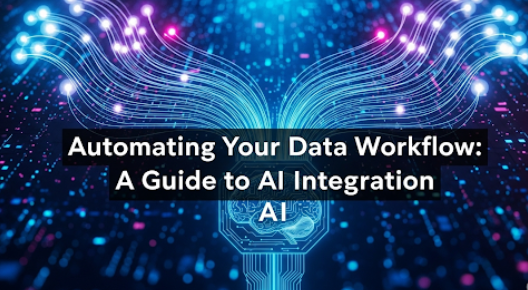Automating Your Data Workflow: A Guide to AI Integration
Companies are inundated — and I mean completely dominated — by data in today’s fast-paced business world. That much data is generated from every click, purchase and interaction that it becomes impossible for the majority of teams to cope. The answer to this is data workflow automation – and AI can now help transform raw data into meaningful insights more seamlessly than ever.
In this guide, you will learn all about how to automate your data processes with AI tools. You will learn practical ways to save time and effort, reduce mistakes — whether you own a small business or work for a big corporation.
The Power of Data Workflow Automation
Data Workflow Automation is establishing the working of your data tasks in a process to work on its own without any necessary human intervention. Basically, it is like having an all-knowing assistant that works 24×7, scraping information into data forms and processing it while you can attend to more important pursuits.
The magic occurs when you throw AI into the equation. While traditional automation only knows how to follow preset rules, AI can adapt and learn based on your data patterns. What this means is that you do need to set up systems or automations that can learn over time but, once you have these, they get more clever as time goes on thus picking up issues you might overlook and identifying opportunities that may be hiding elsewhere.
How Manual Data Work is Costing You More Than You Think
Before we get into the solutions at hand, let’s break down what manual data processing is really costing your business.
- Data scientists can spend 80% of their time cleaning and preparing data
- Errors due to the fact that it is done by humans: manual entry of data has an error rate between 1–5%, and this adds up faster than you can imagine
- Slow decisions: Time is lost while you wait to receive a report from the manual process, missing valuable business moments
- Repetitive data tasks ⇒ employee burnout ⇒ job dissatisfaction, high turnover
Such issues will likely be compounded as time passes, which makes automation not a mere convenience but actually part of our DNA for successful businesses.
The Cornerstone of Smart Data Workflows
A successful automated data workflow comprises five key components, each functioning in harmony like cogs of the wheel.
1. Data Collection and Ingestion
This is the starting point of your data journey. Information today can for instance be automatically parsed from dozens of sources by modern AI systems:
- Customer databases and CRM systems
- Social Media and Website Analytics
- IoT sensors and mobile applications
- External data feeds and third-party APIs
The best part? Artificial Intelligence (AI) can deal with a variety of data formats and you do not need to go ahead and implement conversion yourself. Smart ingestion tools adjust their behavior automatically whether it be spreadsheets, JSON files or data streams.
2. Data Cleaning and Validation
Raw data is messy. AI-powered cleaning tools can:
- Remove duplicates with smart matching algorithms
- Remove inconsistencies in the date format & phone numbers, fix errors related to formatting
- Impute the missing values with predictive modeling inferences
- Identify fraud or errors that could be adjusted by the system
| Manual Cleaning | AI-Powered Cleaning |
|---|---|
| Hours per dataset | Minutes per dataset |
| 95% accuracy rate | 99.5% accuracy rate |
| Inconsistent results | Standardized process |
| Requires expert knowledge | Works with any data type |
3. Data Transformation and Processing
This step is the preparation method for your easily consumable clean data. AI excels at:
- Making new variables out of old ones
- Rescaling scales (to compare metrics to coverage)
- Combining the records which are similar for further analysis
- Calculating complex metrics automatically
4. Analysis and Pattern Recognition
Here’s where AI really shines. Machine learning algorithms can:
- Notice trends we humans could miss
- Analyze historical patterns and predict future outcomes
- Detect anomalies that may indicate real concerns or potential opportunities
- Segment customers by activity
5. Automated Reporting and Alerts
The last piece is how to get insights seen by decision-makers:
- Real-time updatable dynamic dashboards
- Regularly issued reports to the board
- Intelligent notifications emitted when significant metrics change
- Easily comprehensible visual exploration of complex data via interactive graphs and charts
Step-by-Step Implementation Strategy
Starting with automating your data workflows doesn’t have to feel like a daunting task. A simple roadmap, useful to any size company:
Phase 1: Review (Week 01-02)
Current state data process mapping:
- List all sources of data used by your organization
- Record manual frequently performed tasks
- Pinpoint pain areas that cause most of the errors or delays
- Define what you want to accomplish
Quick wins to look for:
- Time-consuming reports
- Tasks in data entry (performed 20+ times a day)
- Cross system data extraction calculation
- Processes prone to human error
Phase 2: Selecting and Setting Up Your Tools (Weeks 3–4)
Select the tools that are most suited to your needs and technical abilities:
For beginners:
- Use Zapier or Microsoft Power Automate for easy to do simple ones
- Tableau or Power BI for management console
- Google Analytics Intelligence for web data insights
For intermediate users:
- Apache Airflow for complex workflows
- DataRobot or H2O.ai for machine learning
- Snowflake or BigQuery for data warehousing
For advanced teams:
- Custom Python or R scripts using scikit-learn
- Real-time data streaming with Apache Kafka
- Deep learning models: TensorFlow or PyTorch
Phase 3: Pilot Implementation (Week 5–8)
- Pick one high-impact workflow to get going
- Choose a task that has measurable success metrics
- Implement basic automation using your tool choice
- Test with real data but along a narrow scope
- Check the performance, gather some feedback to make it work
- Iterate the process according to what you learn
Phase 4: Growth & Improvement (Week 9–12)
After your pilot is established:
- Scale across more workflows with what you have learned
- Incorporate advanced AI capabilities, such as predictive analytics
- Connect systems for frictionless data flow
- Train your team on new processes and tools
AI-Powered Tools for Automating Data
There are so many options in the market but here are the best tools to be taken as per your business requirements:
All-in-One Platforms
Microsoft Azure Machine Learning
- Ideal for businesses already committed to Microsoft products
- Drag-and-drop interface for non-technical users
- Excellent Excel, Power BI integration
- Starting at around $10/month
Amazon SageMaker
- Powerful machine learning capabilities
- Pay-only-for-what-you-use pricing model
- Excellent for handling large datasets
- Requires some technical knowledge
Google Cloud AI Platform
- Best-in-class natural language processing
- Great image and video analysis capabilities
- Best free tier with easy to get started
- Integrates well with Google Workspace
Specialized Solutions
Alteryx
- User-friendly data preparation and analysis
- Almost no coding necessary for basic tasks
- Strong community support and tutorials
- Higher cost but excellent ROI
DataRobot
- Automated machine learning for predictions
- Translates AI decisions into English
- Suited for non-data science background teams
- Enterprise-focused pricing
Tableau with Einstein Analytics
- Combines visualization with AI insights
- Automatically asks questions of your data
- Great for creating interactive dashboards
- Subscription-based pricing model
Real-World Success Stories
Case Study 1: E-commerce Revenue Optimization
Problem: A cluttered online retailer was losing revenue from inventory moving too slowly and poor product recommendations, killing their sales.
Solution: They automated their data workflow allowing them to:
- Pull sales data from all channels, every hour
- Use AI to predict demand for all products
- Automatically adjust inventory levels
- Generate personalized product recommendations
Results:
- 22.5% revenue growth in 6 months
- 40% reduction in out-of-stock situations
- Customer satisfaction scores up by 15%
- 60% faster manual inventory management
Case Study 2: Healthcare Cost Optimization
Use Case: A hospital system wanted to see patient treatment costs and outcomes more clearly.
Solution: They developed an automated system that:
- Collected data from electronic health records
- Analyzed treatment patterns with machine learning
- Identified cost-saving opportunities automatically
- Provided department heads with daily reports
Results:
- Annual cost savings of $2.3 million
- 18% reduction in average patient stay
- 70% faster report generation
- Decision-making based on data resulting in improved patient outcomes
Case Study 3: Quality Control in Manufacturing
Problem: A manufacturing company was experiencing quality problems resulting in defective products going from the warehouse to customers.
Solution: They incorporated AI automation for the following purposes:
- Real-time monitoring of sensors on production lines
- Catch quality problems before products are complete
- Automatically adjust machine settings
- Track quality trends over time
Results:
- 67% reduction in defective products
- 45% decrease in customer complaints
- $890,000 in annual savings from warranties
- 30% improvement in production efficiency
Overcoming Common Challenges
Unfortunately, every automation implementation plan has holes and does not go according to plan. Below are the five common roadblocks and how to deal with them:
Data Quality Issues
Issue: Continuous automation works – but only with consistent data structures; garbage in = garbage out
Solution:
- Enforce data validation rules upstream
- Perform continuous quality checks on data
- Set up feedback loops to detect and solve issues early
- Teach employees how to enter data correctly
Integration Complexity
Issue: Systems don’t integrate well
Solution:
- Focus on native integration systems
- Leverage middleware platforms such as MuleSoft or Boomi
- Utilize easily accessible cloud-based solutions
- Make a plan for API development if required
Team Resistance
Issue: Employee fear of job displacement from automation
Solution:
- Communicate clearly about automation goals
- Demonstrate that automation is creating more engaging work, not eliminating work
- Include employees in automation design
- Provide training for new tools and processes
Security and Compliance Concerns
Issue: Automated systems generate new security vulnerabilities
Solution:
- Select highly-secured certified tools
- Enforce access controls and monitor access
- Conduct security audits on regularly automated tasks
- Comply with all relevant regulations (GDPR, HIPAA, etc.)

Cost-Benefit Analysis Framework
Investigate the financial implications of automation before you invest in it. Here’s an easy way to calculate ROI:
Cost Calculations
One-time costs:
- Software licenses and setup fees
- Implementation and consulting services
- Training and change management
- Hardware upgrades if needed
Ongoing costs:
- Monthly or annual software subscriptions
- Maintenance and support
- Additional staff training
- System updates and improvements
Benefit Calculations
Time savings:
- Hours saved per week × hourly wage rates
- Faster decision-making value
- Reduced overtime costs
Quality improvements:
- Error reduction savings
- Customer satisfaction improvements
- Compliance risk reduction
New capabilities:
- Revenue from better insights
- Cost savings from optimization
- Competitive advantages
ROI Formula
Return on Investment (ROI) = (Total Benefits – Total Costs) / Total Costs × 100
The vast majority of businesses experience a positive ROI in 6-18 months with benefits increasing year-on-year.
Future Trends in Data Workflow Automation
The field is evolving rapidly. What to watch for in the next few years:
No-Code/Low-Code Solutions
The tools are getting easier to use by non-technical users. Enterprise business analysts and operations managers with no programming experience can build powerful automation.
Edge Computing Integration
Reduced latency: By processing data closer to its point of origin, you can remove delays and make real-time decisions. This is highly useful for IoT and mobile apps.
Explainable AI
With AI getting more sophisticated, everyone is looking to make sense of what the systems are thinking in simple English. This is more significant for any regulated industry and trust aspects.
Automated Machine Learning (AutoML)
There are now several AI systems that can build and optimize other AI systems. This will democratize the key aspect of any firm—advanced analytics.
Real-Time Everything
Real-time data streams are replacing batch processing. Insights are demanded immediately, not in hours or days.
Frequently Asked Questions
What does it take to have a data workflow automation up and running?
For easy workflows, many businesses can get results in just 4–8 weeks! Enterprise implementations can be more complex and might take up to 3-6 months. Begin by starting small, and make your way up.
At what point do we have enough data for AI to work?
Typically, the more data you have, the better AI functions, however there are many tools that can function well even with small amounts of data. Machine learning algorithms are good at finding patterns even with a small number, say 400 records. Quality of data is more important than quantity.
Is data workflow automation affordable for small businesses?
Absolutely. Pay-as-you-go pricing for cloud-hosted tools can scale with your usage. Many businesses offer free tiers at the beginning, and then later convert to paid plans once they are convinced of the value, which can very likely be greater than the cost of implementing automation.
What about guaranteeing data security with automated systems?
Ensure the vendors are well reputed and do a background check of security certificates. Use appropriate access controls, encrypt sensitive data, and always audit your systems. In fact, many cloud platforms have significantly better protection than on-premises solutions.
But what if the AI gets it wrong?
A good automation system involves oversight by humans and the ability to override AI decisions. The progression: first AI giving human-vetted recommendations, before fully self-contained automated systems.
Do I need a data scientist to install workflow automation?
Not necessarily. Most modern tools are targeting the business user who does not have a technical background. For some organizations, having the right data skills can unlock additional value from your investment.
How do I know that all of my automation work is successful?
Measure metrics such as time savings, error reduction, decision velocity and business results. In the vast majority of organizations, improvements in efficiently capturing and processing documents have allowed for better accuracy with routing, classification, data extraction and the enterprise as a whole.
Can automation work with legacy systems?
Yes, but it might need more implementation work. Some software automation systems even come with connectors or can be integrated through middleware with popular legacy systems.
Getting Started Today
Data workflow automation is no longer the tool of the tech giants. With the right approach and tools, it is something that any business can implement very quickly.
Keep these points in mind as you kick-off your automation journey:
- It is advisable to begin using high-impact, low-risk processes
- When it comes to data, never forget that squeaky clean, accurate data is much more valuable than a huge heap of messy data
- Get your team involved in planning and implementation to ensure adoption of the new process
- Track metrics so you can justify value and maximize performance
- Be flexible: Your requirements will change when you grow your business
The enterprises that succeed in the future will be the ones who can convert data into decisions faster than their competitors. With automating AI in data workflows, it’s not a matter of just saving work either — it’s a competitive advantage that compounds over time.
The technology is there, we have all the tools we need, and the ROI has been proven. The only thing left to ask is: when will you begin?
If you’re dealing with customer data, financial reports, or operational metrics in your spreadsheets, there is an automation solution to address this. Start today by finding one manual process to automate. You will thank yourself for this (and so will your bottom line).

